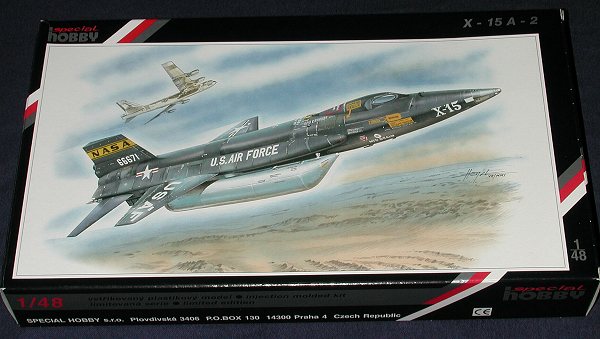
|
KIT: |
Special Hobby 1/48 X-15A-2 |
|
KIT # |
48008 |
|
PRICE: |
$39.98 MSRP |
|
DECALS: |
Two schemes; one aircraft |
|
REVIEWER: |
|
|
NOTES: |
Short run kit |

|
HISTORY |
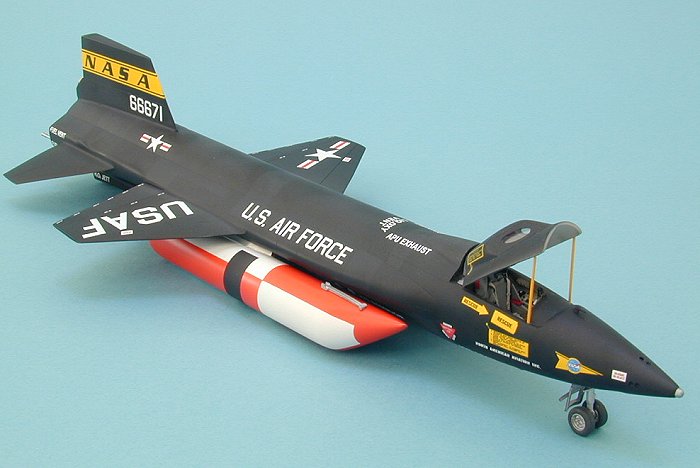
The X-15 program, began in 1954, was an ambitious effort to develop a hypersonic aircraft that could explore the upper edges of the atmosphere. Milt Thompson, Joe Engle, Joe Walker, Bill Dana, Scott Crossfield, Neil Armstrong, Robert White, Pete Knight, and other famous test pilots flew the X-15 higher, faster, and farther than anyone before or since. The X-15 established absolute speed (Mach 6.7 – 4,534 MPH) and altitude records (354,200 feet -- 67 miles) that still stand today. One hundred and ninety nine flights were conducted between 1959 and 1968, and several of the pilots were granted official astronaut status as they exceeded a height greater than 50 miles above the surface of the earth. Even more than thirty years since its last flight, with the exception of the Space Shuttle, no aircraft has flown even half as fast or half as high as the X-15.
Manufactured by North American Aviation, the X-15 was made of a mostly titanium frame and was skinned with a special chrome-nickel alloy called Inconel X. It was eventually equipped with a Reaction Motors XLR-99 rocket motor producing 57,000 pounds of thrust. Like the earlier X-1, X-2, and D-558 programs, the X-15 was loaded aboard a mothership (this time a converted B-52), fueled with liquefied oxygen and anhydrous ammonia (hydrogen peroxide was used for the reaction control jets), flown to 45,000 feet, and released to begin its ten-to-twelve minute mission which ended in an unpowered glide to the Rogers Dry Lake landing strip at Edwards Air Force Base in California.
 Three airframes were made, with the second X-15 being rebuilt by North
American after suffering a crash-landing in 1962. It rolled out two years
later and was called the X-15A-2, which is the subject of the Special Hobby
kit. A twenty-eight inch fuselage extension allowed space for liquid hydrogen
fuel for an experimental ramjet, which was test flown but never operated. It
also could accommodate two large external fuel tanks, which carried liquid
oxygen and liquid ammonia and provided another sixty seconds’ worth of
propulsion. The canopy was modified with ‘eyebrow" shields to protect the
glass from the searing heat that was encountered during the re-entry phase of
the mission. For the record-breaking speed and altitude missions, the X-15A-2
was covered with a special white ablative coating that helped keep the
airframe from melting, as temperatures of 1300 degrees F were encountered
during the re-entry phase.
Three airframes were made, with the second X-15 being rebuilt by North
American after suffering a crash-landing in 1962. It rolled out two years
later and was called the X-15A-2, which is the subject of the Special Hobby
kit. A twenty-eight inch fuselage extension allowed space for liquid hydrogen
fuel for an experimental ramjet, which was test flown but never operated. It
also could accommodate two large external fuel tanks, which carried liquid
oxygen and liquid ammonia and provided another sixty seconds’ worth of
propulsion. The canopy was modified with ‘eyebrow" shields to protect the
glass from the searing heat that was encountered during the re-entry phase of
the mission. For the record-breaking speed and altitude missions, the X-15A-2
was covered with a special white ablative coating that helped keep the
airframe from melting, as temperatures of 1300 degrees F were encountered
during the re-entry phase.
The X-15 program was a very significant contributor to NASA’s understanding of the rigors of ultra-high speed flight and its legacy can be directly seen in today’s Space Shuttle vehicle. Dr. Hugh L. Dryden, for which the famous NASA lab is named for, called the X-15 "the most successful research plane in history".
Is there any aircraft cooler than the X-15? Not to me. This somewhat sinister-looking black airplane with its stubby wings, landing skids, and long tapered fuselage embodies the unbounded enthusiasm of the atomic age. When I saw that Special Hobby announced the kit, I knew immediately that I had to have one. The first production batch of this limited run kit sold out quickly, so I had to cool my heels while I waited patiently for the day when my friendly US postal carrier delivered the eagerly awaited package from GreatModels Webstore. When it finally arrived, I began to work on it that very day.
|
THE KIT |
Scott Van Aken did an excellent preview of this kit, which you can view here.
Like most limited run offerings from the Czech Republic this multimedia kit is packed in a box that only opens on the ends, like a cereal box. I immediately transferred the contents to a more useful box that I could work out of. The simple shape of the aircraft lends to the relatively few number of plastic components, which are molded in a medium gray styrene that has a slightly grainy texture with very fine engraved panel lines. Large sprue attachment points have to be removed, particularly on the backsides of the vertical stabilizer pieces. The kit provides the two large external fuel tanks that were used on the more extreme altitude flights. There are quite a few resin pieces, including the cockpit and a very large plug for the rocket motor exhaust and entire back end of the aircraft. Since the resin landing skids are depicted in the retracted position, a special ground trolley, also entirely made of resin, is provided. Extra parts to detail the fuel tanks and landing gear are also cast in resin. Finally, a piece of clear acetate is included for use in filling the space for the canopy hatch windows.
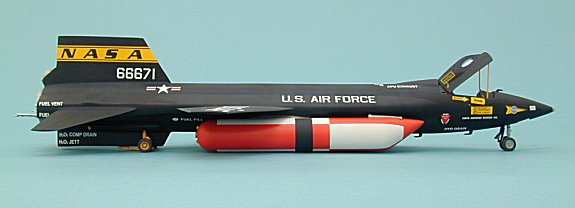 There are no placement locator pins on most of the parts, as expected for a
kit of this type. The two fuselage halves consist of top and bottom pieces,
rather than the traditional left and right configuration. The holes for the
reaction jets in the nose are merely scribed on the surface. The wings have a
single peg to assist in placement, but they are essentially butt joined to the
fuselage, as are the horizontal stabilizers. The vertical horizontal
stabilizers are multi-piece affairs with resin details. If one is going to
pose the aircraft on the ground on its trolley, the modeler has to cut off the
lower two thirds of the bottom stabilizer and affix the speed brake assembly
inside.
There are no placement locator pins on most of the parts, as expected for a
kit of this type. The two fuselage halves consist of top and bottom pieces,
rather than the traditional left and right configuration. The holes for the
reaction jets in the nose are merely scribed on the surface. The wings have a
single peg to assist in placement, but they are essentially butt joined to the
fuselage, as are the horizontal stabilizers. The vertical horizontal
stabilizers are multi-piece affairs with resin details. If one is going to
pose the aircraft on the ground on its trolley, the modeler has to cut off the
lower two thirds of the bottom stabilizer and affix the speed brake assembly
inside.
Decals cover three periods of time in the life of the X-15A-2, serial number 56-6671. First up is the early period where the aircraft had large "X-15" lettering on the nose. Black markings for the record-breaking flights of 1967 in the all-white ablative coating are included, and then the final set of markings for how the aircraft looks today as it sits in the Air Force Museum at Wright-Patterson AFB in Dayton, Ohio. There were some mistakes made on the initial decal sheet, as Special Hobby provides a small correction sheet. The decals are of very high quality, a hallmark of Czech kits.
Other reviewers have noted that the nose profile of the kit is slightly "swollen" when compared to photographs of the real thing. To my eye, it isn’t blatantly noticeable and in any case, a lot of tedious sanding would be necessary to correct it.
|
CONSTRUCTION |
 As usual, I started by painting the cockpit. I used overall Dark Gull Gray
FS 36231 for the floor and ejection seat, with Light Gull Gray FS36440 walls
and front and side panels. The instrument panel features featureless dials,
which I painted black and tried to draw in a few instrument features with a
white pencil. It was finished with a drop of Micro Crystal Clear on each dial
to represent the glass face. I found the detail in the cockpit to be slightly
crude in execution – good enough for me, but not of the quality one gets from
the aftermarket vendors. The ejection seat has some stabilization wings that
attach to the side of the headrest that are confusing to attach. I recommend
looking at the photos at The Ejection Site mentioned in the references below
for location and painting reference.
As usual, I started by painting the cockpit. I used overall Dark Gull Gray
FS 36231 for the floor and ejection seat, with Light Gull Gray FS36440 walls
and front and side panels. The instrument panel features featureless dials,
which I painted black and tried to draw in a few instrument features with a
white pencil. It was finished with a drop of Micro Crystal Clear on each dial
to represent the glass face. I found the detail in the cockpit to be slightly
crude in execution – good enough for me, but not of the quality one gets from
the aftermarket vendors. The ejection seat has some stabilization wings that
attach to the side of the headrest that are confusing to attach. I recommend
looking at the photos at The Ejection Site mentioned in the references below
for location and painting reference.
I glued the cockpit and nose wheel tubs into the fuselage halves, being careful that neither got in the way of each other. Placement is very arbitrary, and I think my cockpit piece is mounted slightly askew as the instrument panel popped up higher than the coaming, which is wrong. I fixed it by sanding the top of the panel down and replacing the central instrument (a clock, maybe?) with a small square of sheet styrene. Photo-etched seat harnesses where added and painted a light gray. After gluing the canopy halves together and filling the seams, I added a few details like piping and wiring, made out of pieces of brass and copper wire, using photos of open X-15 hatches as a guide. I had originally intended to use Micro Crystal Clear as a medium for the clear glass portions of the hatch, but I was unsuccessful in getting it to span the opening, so I used the clear acetate sheet, which was not very satisfactory. It scratched easily and did not conform to the curved shape very well.
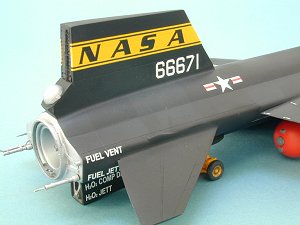 My fuselage halves were slightly warped in a banana shape, but gluing them
together took care of the problem. I added the wings and filled the resultant
seams with gap-filling CA glue. I then worked on the two vertical stabilizers.
Cutting out the bottom two-thirds of the lower stabilizer and adding the resin
speed brake pieces was tricky as placement is not clearly evident in the
instruction sheet. I consulted some photos of the Air Force Museum X-15 and
did the best I could with the limited information I had, not convinced that I
got it right. The very top piece of the upper stabilizer has some obvious gaps
that I could not fill and sand without obliterating the ribbing detail there.
I figured it would look better seamless than not and sanded the three ribs
off. The fit of the vertical stabilizers is uncertain, and I used CA glue to
smooth out the resultant gaps. The same is true of the horizontal stabilizers,
which are again a butt join to the side of the fuselage.
My fuselage halves were slightly warped in a banana shape, but gluing them
together took care of the problem. I added the wings and filled the resultant
seams with gap-filling CA glue. I then worked on the two vertical stabilizers.
Cutting out the bottom two-thirds of the lower stabilizer and adding the resin
speed brake pieces was tricky as placement is not clearly evident in the
instruction sheet. I consulted some photos of the Air Force Museum X-15 and
did the best I could with the limited information I had, not convinced that I
got it right. The very top piece of the upper stabilizer has some obvious gaps
that I could not fill and sand without obliterating the ribbing detail there.
I figured it would look better seamless than not and sanded the three ribs
off. The fit of the vertical stabilizers is uncertain, and I used CA glue to
smooth out the resultant gaps. The same is true of the horizontal stabilizers,
which are again a butt join to the side of the fuselage.
 The worst fitting component by far is the large resin plug that makes up
the entire end of the aircraft and rocket exhaust. I poured what seemed like
gallons of CA glue into the huge gaps there and wiped out all the detail
surrounding the exhaust ring, which I replaced with strips of sheet styrene. I
also added a new fuel vent tube made from stainless steel tubing since I had
destroyed that with all the sanding as well.
The worst fitting component by far is the large resin plug that makes up
the entire end of the aircraft and rocket exhaust. I poured what seemed like
gallons of CA glue into the huge gaps there and wiped out all the detail
surrounding the exhaust ring, which I replaced with strips of sheet styrene. I
also added a new fuel vent tube made from stainless steel tubing since I had
destroyed that with all the sanding as well.
I built the trolley out of the resin pieces, having a rough time getting the wheels to be perfectly round because of the large pour stub attachment points. I know that over time the resin will bend under the weight of the model, so I cheated and added a little piece of plastic underneath the trolley that will contact the ground and take the stress off the suspension.
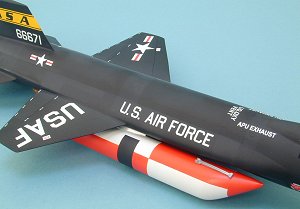 I was undecided about using the external fuel tanks, as they weren’t used
very often in the X-15 program and they introduce a lot more work for
the modeler. But I fell in the love with the International Orange and white
paint scheme on the tanks and figured that the number of times that I would be
able to paint such fun colors on an airplane model were very few and far
between. How can one resist orange and white checkerboard patterns? Not me!
I was undecided about using the external fuel tanks, as they weren’t used
very often in the X-15 program and they introduce a lot more work for
the modeler. But I fell in the love with the International Orange and white
paint scheme on the tanks and figured that the number of times that I would be
able to paint such fun colors on an airplane model were very few and far
between. How can one resist orange and white checkerboard patterns? Not me!
After checking the seams for invisibility and rescribing all the necessary panel lines that I had accidentally erased, I drilled out reaction jet nozzles with a twist drill to give them some dimensionality. I washed the model with a little dishwashing soap and warm water and let it air dry before moving out to the paint shop.
|
PAINT & DECALS |
 You would think that an all-black airplane would be easy to paint, but you
would be wrong. The X-15 weathered quite a bit, and individual panels are more
apparent than others. I first started by painting the overall model with
Testors Acryl Aircraft Interior Black, which I had hoped was really a very
dark gray rather than a pure black. I discovered that I was wrong, as when I
masked off a few panels and sprayed them with just plain Testors Acryl Flat
Black, there was no difference whatsoever. Not deterred, I mixed my own
slightly lightened black by adding about thirty drops of flat white to roughly
a quarter bottle of flat black and sprayed that on various panels. The
difference is not really apparent in the photos of the model, but can be seen
when viewing the model in person. It is a very subtle effect.
You would think that an all-black airplane would be easy to paint, but you
would be wrong. The X-15 weathered quite a bit, and individual panels are more
apparent than others. I first started by painting the overall model with
Testors Acryl Aircraft Interior Black, which I had hoped was really a very
dark gray rather than a pure black. I discovered that I was wrong, as when I
masked off a few panels and sprayed them with just plain Testors Acryl Flat
Black, there was no difference whatsoever. Not deterred, I mixed my own
slightly lightened black by adding about thirty drops of flat white to roughly
a quarter bottle of flat black and sprayed that on various panels. The
difference is not really apparent in the photos of the model, but can be seen
when viewing the model in person. It is a very subtle effect.
The rear of the model and the nose gear well was sprayed with Floquil Old Silver, with the exhaust area getting a coat of Testors Metalizer Stainless Steel. The nose gear landing strut and wheels were painted with Testors Metalizer Steel. The trolley was first primed with flat white and then painted overall Polly Scale Signal Yellow. The most work in painting went to the fuel tanks. I got this looking perfect (or so I thought) and made the mistake of looking at reference photos of the X-15A-2 at the Air Force Museum and realized that I had made a serious goof in the way I had rendered the pattern (it was rotated about 45 degrees from the proper orientation along the centerline of the tanks). Sadly, I had to strip everything off and start over again.
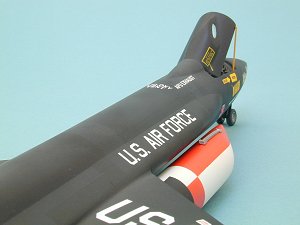 Many coats of Future Floor Polish were applied to make the surface of the
model very glossy in preparation of the decals. I didn’t want any silvering,
as it would stand out like the proverbial sore thumb on the all-black finish.
The decals went on very nicely, and I was very impressed with their quality. I
was afraid that the white and the yellow markings would be translucent, like I
have experienced in other Czech kits, but these were amazingly opaque. I was
also worried that the decals would stick to the model instantly and not be
able to be positioned, like Propagteam decals sometimes are, but that wasn’t
true on this kit. Still, I accidentally got a couple of the smaller stencils
folded over on themselves and couldn’t fix them, so a few markings on the nose
are missing. Drat! I also messed up the placement of the aircraft data block
stencil due to carelessness. Double drat! I hope X-15 fanatics aren’t too
unkind.
Many coats of Future Floor Polish were applied to make the surface of the
model very glossy in preparation of the decals. I didn’t want any silvering,
as it would stand out like the proverbial sore thumb on the all-black finish.
The decals went on very nicely, and I was very impressed with their quality. I
was afraid that the white and the yellow markings would be translucent, like I
have experienced in other Czech kits, but these were amazingly opaque. I was
also worried that the decals would stick to the model instantly and not be
able to be positioned, like Propagteam decals sometimes are, but that wasn’t
true on this kit. Still, I accidentally got a couple of the smaller stencils
folded over on themselves and couldn’t fix them, so a few markings on the nose
are missing. Drat! I also messed up the placement of the aircraft data block
stencil due to carelessness. Double drat! I hope X-15 fanatics aren’t too
unkind.
I noticed that there might be a misspelling of the word "peroxide" which the kit decals depict as "peroxyde". I don’t know if that was a mistake by the decal artist or NASA, so I left them on the lower horizontal stabilizer and hope that no one notices. After the decals were dry, I cleaned up the leftover glue residue and sprayed an overcoat of AeroMaster Acrylic Clear Flat.
|
FINAL ASSEMBLY |
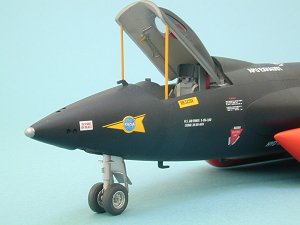 I wanted to display my X-15A-2 with the canopy hatch open, so I drilled
holes in the hatch and the cockpit sill to accept cut lengths of stiff wire,
which I painted yellow. The hatch was placed on top of these pieces and the
rear affixed to the fuselage with a tiny blob of Blu-Tak. I installed a small
piece of paper clip as a pin into each fuel tank and drilled a hole in the
fuselage to accept it, using CA glue to attach the tanks. The alignment is
quite fussy here, and precision placement is not made easier by indifferently
shaped attachment pieces. I did the best I could. I drilled a couple of holes
on the underside of the fuselage and attached the trolley permanently to the
model. As stated previously, modelers should be aware of the propensity of
resin to bend under weight. I drilled out and placed pins in both of the
fragile fuel vent tubes that extend past the end of the rocket exhaust and
carefully put them on the model with a friction fit only so I can transport
the model with some probability of not breaking them.
I wanted to display my X-15A-2 with the canopy hatch open, so I drilled
holes in the hatch and the cockpit sill to accept cut lengths of stiff wire,
which I painted yellow. The hatch was placed on top of these pieces and the
rear affixed to the fuselage with a tiny blob of Blu-Tak. I installed a small
piece of paper clip as a pin into each fuel tank and drilled a hole in the
fuselage to accept it, using CA glue to attach the tanks. The alignment is
quite fussy here, and precision placement is not made easier by indifferently
shaped attachment pieces. I did the best I could. I drilled a couple of holes
on the underside of the fuselage and attached the trolley permanently to the
model. As stated previously, modelers should be aware of the propensity of
resin to bend under weight. I drilled out and placed pins in both of the
fragile fuel vent tubes that extend past the end of the rocket exhaust and
carefully put them on the model with a friction fit only so I can transport
the model with some probability of not breaking them.
|
CONCLUSIONS |
This is the only game in town for a 1/48 scale X-15. The completed model looks very striking in all black, contrasted with the yellow and white markings. Some might complain that the earlier X-15s, airframes one and three, were not the subject of the kit, but Special Hobby elected to go with the stretched version which set all the world records. Others have decried the lack of extended landing skids, which I would have preferred as well. But you get what you get. I found it to be a quite challenging project, like all limited run kits that I have encountered. A lot of work is needed to accommodate the fact that nothing really fits very well. With lots of patience and an eye towards keeping everything properly aligned, a decent replica of the coolest airplane that ever took the skies can be had. Recommended to all experienced modelers.
|
REFERENCES |
Coyne, Kevin: The Ejection Site. http://www.ejectionsite.com/x15seat.htm
Dryden Flight Research Center: X-15 Hypersonic Research Program http://www.dfrc.nasa.gov/PAO/PAIS/HTML/FS-052-DFRC.html
Dryden Flight Research Center: X-15 Photo Gallery http://www.dfrc.nasa.gov/gallery/photo/X-15/index.html
Knudsen, Sven: North American X-15A-2 http://www.ninfinger.org/~sven/models/x_planes/x15.html
If you would like your product reviewed fairly and quickly by a site that has well over 100,000 visitors a month, please contact me or see other details in the Note to Contributors.